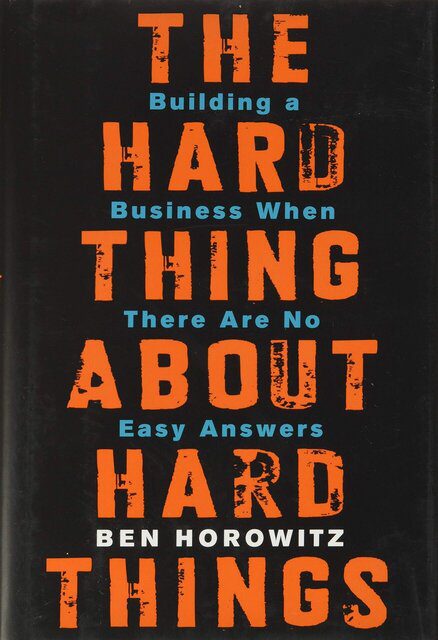“Hard things are hard because there are no easy answers or recipes. They are hard because your emotions are at odds with your logic. They are hard because you don’t know the answer and you cannot ask for help without showing weakness.”
In The Hard Thing About Hard Things: Building a Business When There Are No Easy Answers cofounder of Andreessen Horowitz, Ben Horowitz shares timeliness advice on building and running a startup. Ben tells the story of how his company Opsware went from doomed in the eyes of the world to a $1.6 billion outcome with no recapitalization. He shares war stories including several near bankruptcies, a stock price of $0.35 per share, unlimited bad press, and three separate layoffs where they lost a total of four hundred employees.
Ben describes strategies for laying off employees and executives the right way, communicating effectively, demoting a loyal friend, lessons learned as a founder-ceo, managing the toughest problems and making the tough calls.
Ben shared the insights he’s gained developing, managing, selling, buying, investing in, and supervising technology companies. A lifelong rap fanatic, he amplifies business lessons with lyrics from his favorite songs, telling it straight about everything from firing friends to poaching competitors, cultivating and sustaining a CEO mentality to knowing the right time to cash in.
The Hard Things
The hard thing isn’t setting a big, hairy, audacious goal. The hard thing is laying people off when you miss the big goal. The hard thing isn’t hiring great people. The hard thing is when those “great people” develop a sense of entitlement and start demanding unreasonable things. The hard thing isn’t setting up an organizational chart. The hard thing is getting people to communicate within the organization that you just designed. The hard thing isn’t dreaming big. The hard thing is waking up in the middle of the night in a cold sweat when the dream turns into a nightmare.
Lessons Learned from Bill Campbell
No matter who you are, you need two kinds of friends in your life. The first kind is one you can call when something good happens, and you need someone who will be excited for you. Not a fake excitement veiling envy, but a real excitement.
You need someone who will actually be more excited for you than he would be if it had happened to him. The second kind of friend is somebody you can call when things go horribly wrong—when your life is on the line and you only have one phone call. Who is it going to be? Bill Campbell is both of those friends.
Ben, you cannot let him keep his job, but you absolutely can let him keep his respect.
Product Strategy
It turns out that is exactly what product strategy is all about—figuring out the right product is the innovator’s job, not the customer’s job. The customer only knows what she thinks she wants based on her experience with the current product. The innovator can take into account everything that’s possible, but often must go against what she knows to be true. As a result, innovation requires a combination of knowledge, skill, and courage.
Startup CEOs should not play the odds. When you are building a company, you must believe there is an answer and you cannot pay attention to your odds of finding it. You just have to find it. It matters not whether your chances are nine in ten or one in a thousand; your task is the same.
There is no secret
People always ask me, “What’s the secret to being a successful CEO?” Sadly, there is no secret, but if there is one skill that stands out, it’s the ability to focus and make the best move when there are no good moves. It’s the moments where you feel most like hiding or dying that you can make the biggest difference as a CEO.
The Struggle
- The Struggle is when you wonder why you started the company in the first place.
- The Struggle is when people ask you why you don’t quit and you don’t know the answer.
- The Struggle is when your employees think you are lying and you think they may be right.
- The Struggle is when food loses its taste.
- The Struggle is when you don’t believe you should be CEO of your company. The Struggle is when you know that you are in over your head and you know that you cannot be replaced. The Struggle is when everybody thinks you are an idiot, but nobody will fire you. The Struggle is where self-doubt becomes self-hatred.
- The Struggle is when you are having a conversation with someone and you can’t hear a word that they are saying because all you can hear is the Struggle.
- The Struggle is when you want the pain to stop. The Struggle is unhappiness.
- The Struggle is when you go on vacation to feel better and you feel worse.
- The Struggle is when you are surrounded by people and you are all alone. The Struggle has no mercy.
- The Struggle is the land of broken promises and crushed dreams. The Struggle is a cold sweat. The Struggle is where your guts boil so much that you feel like you are going to spit blood.
- The Struggle is not failure, but it causes failure. Especially if you are weak. Always if you are weak.
- The Struggle is where greatness comes from
WHY IT’S IMPERATIVE TO TELL IT LIKE IT IS
There are three key reasons why being transparent about your company’s problems makes sense:
1. Trust.
Without trust, communication breaks. More specifically:
In a company context, this is a critical point. As a company grows, communication becomes its biggest challenge. If the employees fundamentally trust the CEO, then communication will be vastly more efficient than if they don’t. Telling things as they are is a critical part of building this trust. A CEO’s ability to build this trust over time is often the difference between companies that execute well and companies that are chaotic.
In any human interaction, the required amount of communication is inversely proportional to the level of trust.
2. The more brains working on the hard problems, the better.
In order to build a great technology company, you have to hire lots of incredibly smart people. It’s a total waste to have lots of big brains but not let them work on your biggest problems. A brain, no matter how big, cannot solve a problem it doesn’t know about.
Given enough eyeballs, all bugs are shallow. – Open Source Community
3. A good culture is like the old RIP routing protocol: Bad news travels fast; good news travels slow.
If you investigate companies that have failed, you will find that many employees knew about the fatal issues long before those issues killed the company. If the employees knew about the deadly problems, why didn’t they say something? Too often the answer is that the company culture discouraged the spread of bad news, so the knowledge lay dormant until it was too late to act.
A healthy company culture encourages people to share bad news. A company that discusses its problems freely and openly can quickly solve them. A company that covers up its problems frustrates everyone involved. The resulting action item for CEOs: Build a culture that rewards—not punishes—people for getting problems into the open where they can be solved.
If you run a company, you will experience overwhelming psychological pressure to be overly positive. Stand up to the pressure, face your fear, and tell it like it is.
THE RIGHT WAY TO LAY PEOPLE OFF
STEP 1: GET YOUR HEAD RIGHT
When a company fails to hit its financial plan so severely that it must fire the employees it went to great time and expense to hire, it weighs heavily on the chief executive.
STEP 2: DON’T DELAY
Once you decide that you will have to lay people off, the time elapsed between making that decision and executing that decision should be as short as possible. If word leaks (which it will inevitably if you delay), then you will be faced with an additional set of issues. Employees will question managers and ask whether a layoff is coming. If the managers don’t know, they will look stupid. If the managers do know, they will either have to lie to their employees, contribute to the leak, or remain silent, which will create additional agitation.
STEP 3: BE CLEAR IN YOUR OWN MIND ABOUT WHY YOU ARE LAYING PEOPLE OFF
Going into a layoff, board members will sometimes try to make you feel better by putting a positive spin on things. They might say, “This gives us a great opportunity to deal with some performance issues and simplify the business.” That may be true, but do not let that cloud your thinking or your message to the company. You are laying people off because the company failed to hit its plan. If individual performance were the only issue, then you’d be taking a different measure.
STEP 4: TRAIN YOUR MANAGERS
The most important step in the whole exercise is training the management team. If you send managers into this super-uncomfortable situation with no training, most of them will fail. Training starts with a golden rule: Managers must lay off their own people. They cannot pass the task to HR or to a more sadistic peer. You cannot hire an outsourcing firm like the one in the movie Up in the Air. Every manager must lay off his own people.
STEP 5: ADDRESS THE ENTIRE COMPANY
Prior to executing the layoff, the CEO must address the company. The CEO must deliver the overall message that provides the proper context and air cover for the managers. If you do your job right, the managers will have a much easier time doing their jobs. Keep in mind what former Intuit CEO Bill Campbell told me—The message is for the people who are staying.
STEP 6: BE VISIBLE, BE PRESENT
After you make the speech telling your company that you will be letting many of them go, you will not feel like hanging out and talking to people. You will probably feel like going to a bar and drinking a fifth of tequila. Do not do this. Be present. Be visible. Be engaging. People want to see you. They want to see whether you care. The people whom you laid off will want to know if they still have a relationship with you and the company. Talk to people. Help them carry their things to their cars. Let them know that you appreciate their efforts.
The first principle of the Bushido—the way of the warrior
Keep death in mind at all times. If a warrior keeps death in mind at all times and lives as though each day might be his last, he will conduct himself properly in all his actions. Similarly, if a CEO keeps the following lessons in mind, she will maintain the proper focus when hiring, training, and building her culture.
Peace and Wartime
The world looks one way in peacetime but very different when you must fight for your life every day. In times of peace, one has time to care about things like appropriateness, long-term cultural consequences, and people’s feelings. In times of war, killing the enemy and getting the troops safely home is all that counts.
Being a good company doesn’t matter when things go well, but it can be the difference between life and death when things go wrong. Things always go wrong. Being a good company is an end in itself.
Focus on the road, not the wall.
When someone learns to drive a race car, one of the first lessons taught is that when you are going around a curve at 200 mph, do not focus on the wall; focus on the road. If you focus on the wall, you will drive right into it. If you focus on the road, you will follow the road. Running a company is like that. There are always a thousand things that can go wrong and sink the ship. If you focus too much on them, you will drive yourself nuts and likely crash your company. Focus on where you are going rather than on what you hope to avoid.
COURAGE, LIKE CHARACTER, CAN BE DEVELOPED
In life, everybody faces choices between doing what’s popular, easy, and wrong versus doing what’s lonely, difficult, and right. These decisions intensify when you run a company, because the consequences get magnified a thousandfold. As in life, the excuses for CEOs making the wrong choice are always plentiful.
Every time you make the hard, correct decision you become a bit more courageous and every time you make the easy, wrong decision you become a bit more cowardly. If you are CEO, these choices will lead decision you become a bit more cowardly. If you are CEO, these choices will lead to a courageous or cowardly company.
“Giving feedback turns out to be the unnatural atomic building block atop which the unnatural skill set of management gets built. ”
Peacetime vs Wartime Management
Peacetime in business means those times when a company has a large advantage over the competition in its core market, and its market is growing. In times of peace, the company can focus on expanding the market and reinforcing the company’s strengths.
In wartime, a company is fending off an imminent existential threat. Such a threat can come from a wide range of sources, including competition, dramatic macroeconomic change, market change, supply chain change, and so forth.
“Peacetime and wartime management techniques can both be highly effective when employed in the right situations, but they are very different. The peacetime CEO does not resemble the wartime CEO.”
In peacetime, leaders must maximize and broaden the current opportunity. As a result, peacetime leaders employ techniques to encourage broad-based creativity and contribution across a diverse set of possible objectives. In wartime, by contrast, the company typically has a single bullet in the chamber and must, at all costs, hit the target. The company’s survival in wartime depends upon strict adherence and alignment to the mission.
All the Best in your quest to get Better. Don’t Settle: Live with Passion.



Comments are closed.